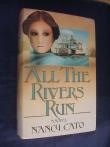 2018222368897707415.jpg
2018222368897707415.jpg
 2018222368897707415.jpg
2018222368897707415.jpg
'Philadelphia Gordon is an artist, a riverboat skipper and a beautiful, independent woman.
'Orphaned by a shipwreck, Philadelphia grows up on the banks of her beloved Murray River in Australia with her kindly uncle and strict aunt, seemingly destined for a conventional life. But then tragedy changes everything, and leads her to a successful career as a painter, and then to a meeting with the dashing captain of the paddle-steamer which bears her name.'
Source: Publisher's blurb (Hachette edition)
 All the Rivers Run
( dir. George T. Miller
et. al. )agent
Melbourne
:
Crawford Productions
Seven Network
,
1983
Z1489602
1983
series - publisher
film/TV
historical fiction
All the Rivers Run
( dir. George T. Miller
et. al. )agent
Melbourne
:
Crawford Productions
Seven Network
,
1983
Z1489602
1983
series - publisher
film/TV
historical fiction
Based on the novel by Nancy Cato, All the Rivers Run begins in 1892 with young Englishwoman Philadelphia 'Delie' Gordon struggling to the Australian shore after being shipwrecked. Except for crusty old sailor Tom Critchley, the shipwreck kills all the other people on the ship, including Delie's family. Delie is subsequently taken in by her kindly Uncle Charles and termagant Aunt Hester, whose small farm is situated beside the Murray River, near the inland port of Echuca. The narrative follows Delie for the next decade or so of her life. She suffers through the difficulties of adolescent love and rebels against conformity, and eventually marries, has children, and pursues a career on the river. Delie later attains commercial and critical success as a painter and earns her Master's Certificate, becoming the first female riverboat captain on the Murray River.